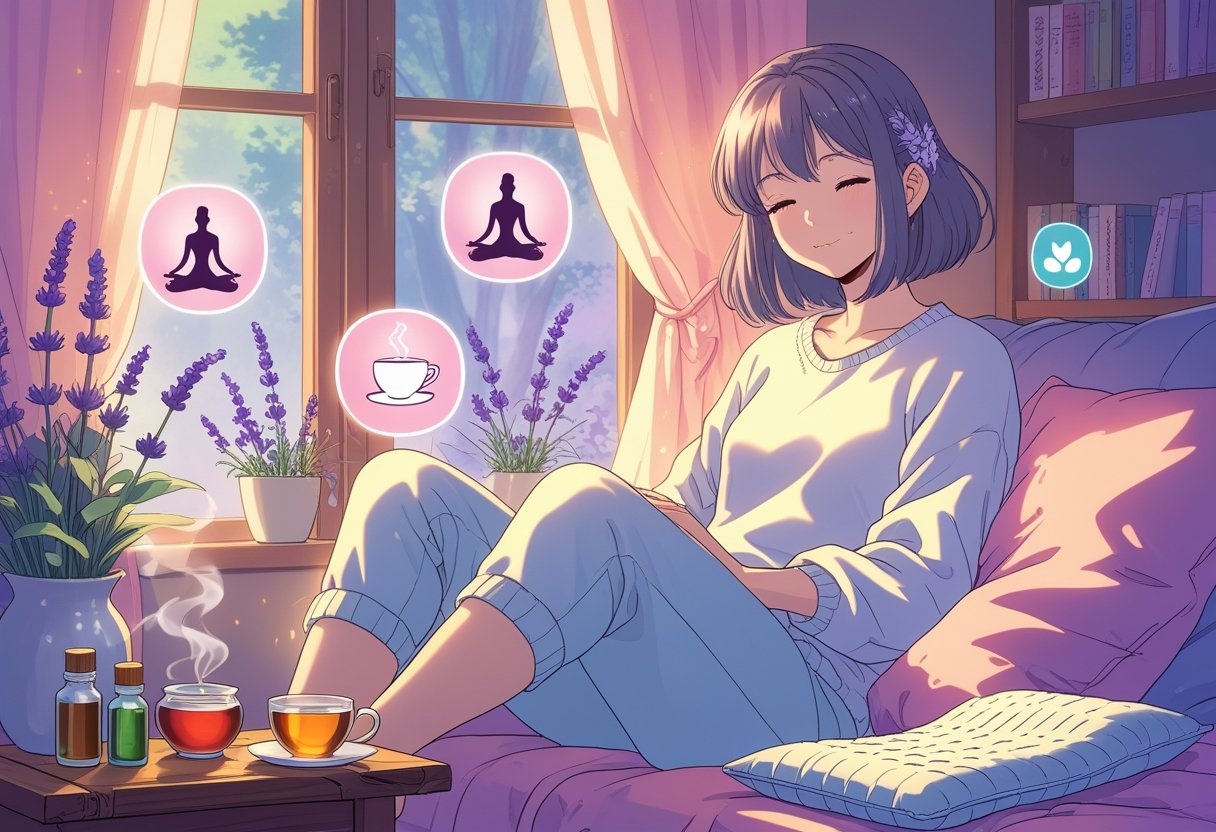Many people experience premenstrual syndrome (PMS) each month, which can bring a mix of physical and emotional symptoms. From mood swings and bloating to headaches and trouble sleeping, these changes can make daily life feel more difficult. Finding relief from PMS is possible with the right strategies, including healthy habits, safe over-the-counter products, and when needed, help from a healthcare provider.

Simple changes, like eating a balanced diet, exercising regularly, and managing stress, can reduce PMS symptoms for many people. Some may also find comfort with certain herbal remedies—such as chasteberry, ginger, or evening primrose oil—and targeted supplements, though it is important to choose reputable options and know when to seek medical advice. If PMS symptoms are severe or disrupt normal activities, it may be time to talk to a doctor about more options.
Key Takeaways
- PMS can affect both the mind and body before a menstrual period.
- Lifestyle changes and some supplements can help manage symptoms.
- Medical advice is important if PMS is severe or not improving.
Understanding PMS and Its Causes
Premenstrual syndrome (PMS) includes emotional and physical symptoms that affect many people before their period starts. These symptoms can change from month to month and may range from mild to severe.
What Is Premenstrual Syndrome?
Premenstrual syndrome is a group of symptoms that happen before a person’s menstrual period starts. Most people start to notice PMS after ovulation and before bleeding begins. PMS is recognized by both physical signs, like bloating, and emotional changes, such as mood swings.
Doctors do not know the exact cause of PMS, but it is believed to be linked to changes in hormone levels during the menstrual cycle. It often begins in the late teenage years or early thirties but can affect people at any age after puberty. Symptoms usually stop during pregnancy or after menopause, when periods end. According to the Mayo Clinic, the symptoms come and go with each cycle.
The Menstrual Cycle and PMS
The menstrual cycle usually lasts about 28 days, with ovulation happening halfway through. After ovulation, hormone levels such as estrogen and progesterone change sharply. These ups and downs are strongly linked to PMS symptoms.
PMS most often appears in the luteal phase, which is the two weeks between ovulation and the next period. The sudden drop in hormones during this time can affect brain chemicals like serotonin, leading to irritability or sadness. Some experts think changes in brain chemistry can make people more sensitive to these symptoms.
Because everyone’s hormones react differently, some people have very few symptoms while others notice a big change each month. Stress and lifestyle habits can also make symptoms worse or more noticeable.
Common PMS Symptoms
PMS has both physical and emotional symptoms. The most common physical symptoms include:
- Bloating or water retention
- Headaches
- Breast tenderness
- Cramps
- Changes in appetite
Emotional or mental symptoms can include:
- Mood swings
- Irritability
- Feeling sad or anxious
- Trouble concentrating
- Trouble sleeping
These symptoms usually begin after ovulation and end with the start of the period. While PMS symptoms can change each cycle, about three out of four people who menstruate report having at least one sign of PMS before their period according to womenshealth.gov. If the symptoms are strong enough to disrupt daily life, it may be helpful to speak with a healthcare provider.
Recognizing Symptoms of PMS
PMS can show up in different ways for different people. It can cause both physical discomfort and changes in mood, usually starting one or two weeks before a period begins.
Physical PMS Symptoms
Physical symptoms are often the first signs that PMS is starting. Many experience cramps in the lower belly. Bloating and water-weight gain are common and may make clothes feel tighter.
Other frequent symptoms include headaches, backaches, and muscle aches, which can make daily tasks harder. Breast tenderness often occurs, sometimes along with mild fluid retention. Some people notice changes in their digestive system, such as constipation or feeling more gassy than usual.
A list of typical physical PMS symptoms:
- Cramps
- Bloating
- Headaches
- Muscle aches
- Backaches
- Constipation
- Water-weight gain
- Breast tenderness
For more on these, visit the Cleveland Clinic’s page about PMS symptoms.
Emotional and Behavioral Changes
PMS can affect emotions and behaviors noticeably. Strong mood changes such as feeling more irritable or crying more often are frequent. Some feel rising anxiety, experience more depression, or find they are easily upset by small things.
Changes in behavior can include trouble sleeping and difficulty concentrating. Food cravings are also a regular issue, leading many to want sweets or salty foods. Tiredness and low energy are common, which may be made worse by lack of sleep.
Key emotional symptoms:
- Irritability
- Mood changes
- Anxiety
- Depression
- Trouble sleeping
- Food cravings
- Fatigue
A full list and more details can be found on the NHS’s PMS symptoms page.
Effective Strategies for PMS Relief

Managing PMS often means combining daily habits with temporary relief methods. Small changes can lessen bloating, cramps, and mood swings, giving people better control of their symptoms.
Lifestyle and Home Remedies
Exercise is one of the most important steps for PMS relief. Regular activity, including walking or light aerobic exercise, may help improve mood and reduce cramps or bloating. Even 20 to 30 minutes, most days of the week, can be helpful.
A balanced diet is key. Try to eat more fruits, vegetables, and whole grains. Foods rich in magnesium—such as spinach, nuts, and seeds—may help with headaches and water retention. Cutting back on caffeine and salty foods can reduce breast tenderness and bloating, as suggested by Cleveland Clinic's advice on PMS symptom relief.
Other options include stress reduction techniques. Simple actions like deep breathing, yoga, or meditation can make PMS symptoms more manageable. Keeping a regular sleep routine and avoiding alcohol may also help. Some people report mild relief from herbal supplements like chasteberry or ginger, but it’s best to talk to a doctor before using new remedies, as noted by the Mayo Clinic.
Over-the-Counter Medications
For temporary relief of physical symptoms, several over-the-counter medications are available. Acetaminophen can help with cramps or headaches. Nonsteroidal anti-inflammatory drugs (NSAIDs), like ibuprofen, can reduce pain and inflammation.
Some people use diuretics to reduce bloating, but these should only be used for short periods and under a doctor’s advice.
Combination remedies made for PMS may contain multiple ingredients such as pain relievers and caffeine. Caffeine in some products can boost alertness but may increase breast tenderness or anxiety for some people. It is important to read medicine labels and use the lowest effective dose for the shortest period needed.
If common medicines do not help or symptoms are severe, talking to a healthcare provider is recommended. They can suggest other treatments or check for different causes of symptoms.
Over-the-Counter Products for PMS
Several over-the-counter (OTC) options can address PMS symptoms such as cramps, bloating, and headaches. These products include pain relievers, medications that reduce excess water, and formulas that target multiple symptoms at once.
Pain Relief Medications
Medications like acetaminophen and ibuprofen are commonly used to reduce menstrual cramps and body aches. These pain relievers are available at most drugstores and can help relieve both mild and moderate pain.
For those with frequent or intense cramps, cramp tabs and products containing pyrilamine maleate are often recommended. Pyrilamine maleate, an antihistamine, is sometimes added for its calming effect on muscles. Many women find that sticking to regular dosing schedules is important to keep symptoms under control.
Some OTC pain relief options also include caffeine to help with fatigue and headaches. It is important to read the labels and follow dosing instructions to avoid side effects like stomach upset or drowsiness.
Products Targeting Fluid Retention
Bloating and water retention are typical PMS symptoms that can make a person feel uncomfortable or weigh more than usual. OTC products containing pamabrom specifically target fluid retention. Pamabrom is a mild diuretic included in several PMS medications.
These products help the body get rid of extra water, which can ease bloating and swelling. Most products with pamabrom require consistent use over a few days for the best results. Usually, pamabrom is well tolerated, but increased urination is common.
It is best to check with a doctor before starting diuretics, especially for those with kidney problems or who are taking other medicines. Some popular brands offering pamabrom include Pamprin and Midol.
Multi-Symptom Formulas
Multi-symptom PMS products combine several active ingredients to address multiple complaints in one dose. These may include acetaminophen for pain relief, pamabrom for bloating, and pyrilamine maleate for mood changes or irritability.
Products like Pamprin Multi-Symptom Formula and Midol Complete are designed to help with cramps, headaches, bloating, and irritability. These formulas sometimes also target fatigue or backaches.
Most multi-symptom formulas are available in tablet or caplet form, with some offering different dosages or ingredients to match specific needs. Always read directions and avoid doubling products to prevent taking too much acetaminophen.
Important Product Information
When choosing a PMS relief product, pay attention to ingredients, common side effects, and whether the packaging or information is provided in Spanish for better accessibility. Understanding these areas helps users make informed decisions for their needs.
Ingredients and Dosage
PMS relief supplements often contain herbal blends and nutrients that target menstrual discomfort. Common ingredients include chasteberry, magnesium, calcium, and essential fatty acids. Some formulas also use herbs like ginkgo biloba or St. John's Wort, which have a history of traditional use for hormone balance.
Look for a product that clearly lists ingredient amounts and suggested daily intake. For instance, several 9-in-1 herbal supplements provide a combination of plant extracts and are available in liquid or gummy form for easier use.
Table: Example Ingredients in PMS Supplements
| Ingredient | Common Benefit |
|---|---|
| Chasteberry | Mood support, cycle comfort |
| Magnesium | Reduces cramps |
| Calcium | Eases bloating, irritability |
| Evening Primrose Oil | Hormonal balance |
Following the recommended dosage printed on the package helps avoid unwanted effects, and some brands offer detailed dosing guidelines.
Possible Side Effects
Most PMS relief products are well-tolerated when used as directed. However, some people may experience mild reactions such as upset stomach, headache, or nausea. Side effects can depend on the body's response to herbal or vitamin blends.
Some herbal ingredients, like St. John's Wort, can interact with medications or cause sensitivity to sunlight. Magnesium taken in high doses may cause diarrhea. Always read package warnings and check with a healthcare provider before starting a new supplement, especially when combining with other treatments.
It is important to stop using the product and seek advice if severe allergic reactions occur, such as swelling or difficulty breathing.
Spanish Labeling and Accessibility
Product labels and instructions are often printed in English, but some brands also provide information in Spanish. This makes the product more accessible to a wider range of users. The availability of Spanish language labeling and support varies by manufacturer and location.
Check the packaging or brand website to see if Spanish instructions, warnings, and ingredient lists are included. Many online retailers display both languages on their product pages, or offer downloadable PDFs with translations.
Clear, bilingual labeling empowers users who prefer Spanish and ensures they understand ingredients, directions, and warnings before use. This is especially helpful for families or caregivers assisting non-English speakers.
When to Consult a Healthcare Provider
If PMS symptoms become difficult to manage or start to affect daily activities, it may be time to seek medical advice. Some people experience mood changes, severe pain, or emotional symptoms that need professional evaluation and support.
Identifying Severe PMS or PMDD
Severe PMS or premenstrual dysphoric disorder (PMDD) can involve symptoms that go beyond usual cramps, headaches, or mild mood swings. Signs may include:
- Persistent sadness or depression
- Intense irritability or anger
- Trouble concentrating
- Extreme fatigue
- Physical symptoms such as migraines, joint pain, or swelling
These symptoms often disrupt work, school, or relationships. If mood changes include thoughts of self-harm or lasting anxiety, this is a clear sign to reach out for help. Severe PMS and PMDD are medical conditions that a healthcare provider can help diagnose and manage. Keeping a symptom diary may also help the provider see patterns and suggest the right treatment.
Professional Treatments and Support
Treatment options from a healthcare provider may include prescription medications, counseling, or hormone therapy, depending on symptom severity. Common approaches are:
- Antidepressants, such as SSRIs, for severe mood symptoms
- Birth control pills to balance hormone levels
- Anti-inflammatory drugs to reduce pain
- Cognitive behavioral therapy (CBT) for emotional support
A doctor may also recommend lifestyle changes or refer to a mental health specialist if needed. Early consultation can help find the most effective plan. Those whose symptoms do not improve with home remedies should contact their healthcare provider for further evaluation and care options.
Frequently Asked Questions
Several strategies can help with PMS challenges such as mood swings, pain, and discomfort. Small changes to habits, nutrition, or lifestyle can make symptoms easier to handle.
How can mood swings be reduced during PMS?
Regular exercise may help lessen mood swings during PMS. Physical activity boosts endorphins, which can improve mood.
Getting enough sleep and learning ways to reduce stress, such as meditation or deep breathing, also make mood changes easier to manage.
What are natural methods for alleviating PMS symptoms?
Eating a diet with plenty of fruits, whole grains, and vegetables can help ease symptoms. Limiting salt and sugar may also reduce bloating and tiredness.
Practicing relaxation techniques such as yoga and stretching can aid in managing stress and discomfort as well. For more information, visit this Mayo Clinic article on PMS.
What strategies can help manage PMS-related anger?
Deep breathing exercises and taking short breaks during stressful moments are helpful. It may help to talk openly about feelings with someone you trust.
Staying active, sticking to a routine, and making time for calm activities like reading can lower anger during PMS.
Which supplements are most effective for PMS mood swings?
Some people find relief from mood swings by taking calcium and vitamin B6 supplements. Magnesium is another option, but results may vary from person to person.
It is best to consult with a health care provider before starting any supplement for PMS.
What can I do to ease PMS discomfort?
Eating smaller, frequent meals may reduce bloating and nausea. Drinking enough water and staying active can also make cramps and swelling less severe.
Over-the-counter pain relievers may help, but talking with a doctor or pharmacist is always recommended. Learn more about PMS comfort tips from ACOG’s FAQ on PMS.
What could be causing an increase in the severity of my PMS?
Changes in hormone levels, stress, or poor sleep can cause PMS symptoms to worsen. Sometimes, diet changes or new medications also play a role.
If symptoms become much stronger or disrupt daily life, a health care provider can help find the cause and suggest next steps.
Conclusion
Effective PMS relief options depend on each person's symptoms. Some find symptom tracking helpful to spot patterns and manage changes in mood and physical discomfort.
Exercise, balanced nutrition, and enough sleep can help many people feel better during PMS. Using relaxation techniques like deep breathing or gentle yoga may help with stress and anxiety.
For moderate to severe PMS, doctors sometimes suggest medication. These treatments might include over-the-counter pain relievers, hormonal birth control, or antidepressants in some cases.
Recent studies have also looked at natural supplements. For example, research shows that curcumin can ease cramps and PMS symptoms for some individuals. Others have tried phospholipids, which showed promise in a study with phosphatidylserine and phosphatidic acid for symptom relief.
There is not enough strong evidence for some herbal remedies, including Ginkgo biloba and St. John's Wort. People should talk with a healthcare provider before starting any new supplement or medication.
Helpful PMS Relief Strategies:
| Strategy | Example |
|---|---|
| Exercise | Walking, cycling |
| Diet | Eating fruits, veggies, whole grains |
| Medication | Ibuprofen, birth control |
| Relaxation | Yoga, deep breathing |
| Supplements | Curcumin, phospholipids |
PMS relief is possible with the right mix of self-care and, if needed, guidance from a healthcare professional. Making small, steady changes may help many people manage their PMS symptoms more effectively.

